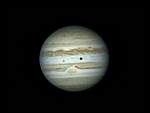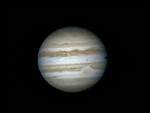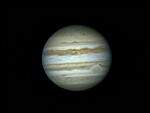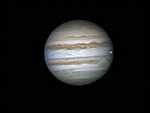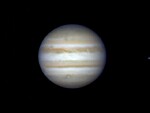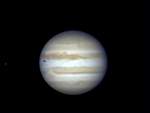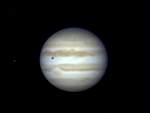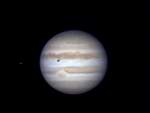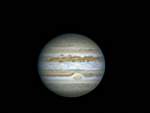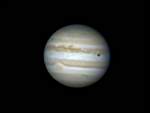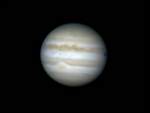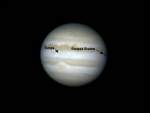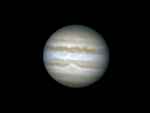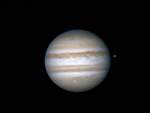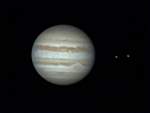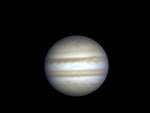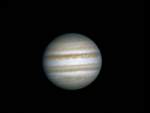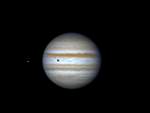
2009 Jupiter Images
Web Camera Images
Capture Notes: Philips SPC900 NC web camera, unless otherwise indicated, with an IR blocking filter. 8 inch Meade LXD55 SCT and 3X barlow.
K3CCDTools version 1 was used to record the videos unless otherwise indicated. Camera settings recorded with WcCrtl unless otherwise indicated.
Processing Notes: Final processing has been done using Registax versions 3 or 4 for stacking, Astra Image for removing diagonal bands through Fast Fourier Transform edits and for applying deconvolution.
PhotoShop CS2 or Paint Shop Pro 9 have been used for adjusting levels, curves and color, while Neat Image is used for digital noise removal.
November 27, 2009 at 0:09 UT.
The boring side of Jupiter. Io is visible to the right. Camera settings: 1/33 second exposure, brightness: 50%, gamma 0%, saturation 100%, gain: 43%. 400 frames stacked. Seeing varied from poor to good (~2 to 4 out of 5). Angular diameter 38.1".
November 21, 2009.
Double transits of the shadow of Io and the moon Ganymede. Io is visible to the right. Io's shadow is the smaller of the two spots on Jupiter's disk. In the last frame you can see the Great Red Spot beginning to come into view. Camera settings: 1/33 second exposure, brightness: 50%, gamma 0%, saturation 50%, gain: 46%. Seeing was poor to average (~2 to 3 out of 5). Angular diameter 38.8".
November 20, 2009 at 0:36 UT.
The boring side of Jupiter. Camera settings: 1/25 second exposure, brightness: 50%. gamma 0%, saturation 100%, gain: 37%. 350 frames stacked. Seeing was poor to average (~2 to 3 out of 5). Angular diameter 38.9".
November 5, 2009 at 0:34 UT.
The Great Red Spot, Io and its shadow. Camera settings: 1/33 second exposure, brightness: 50%. gamma 0%, saturation 100%, gain: 43%. 300 frames stacked. Seeing was good (~4 out of 5). Angular diameter 40.8".
October 18, 2009 at 0:48 UT.
The boring side of Jupiter. Camera settings: 1/33 second exposure, brightness: 50%. gamma 0%, saturation 100%, gain: 48%. 300 frames stacked. Seeing was poor (~2 out of 5). Angular diameter 43.2".
October 10, 2009 at 1:22 UT.
The boring side of Jupiter. Camera settings: 1/33 second exposure, brightness: 50%. gamma 0%, saturation 100%, gain: 43%. 400 frames stacked. Seeing was average (3 out of 5). Angular diameter 44.3".
September 30, 2009.
The boring side of Jupiter. Camera settings: 1/33 second exposure, brightness: 50%, gamma 0%, saturation 50%, gain: 43%. Seeing was good to excellent (between a 4 to 5 out of 5). Angular diameter 45.6".
September 27, 2009.
The Great Red Spot and the transit of Io and its shadow. Camera settings: 1/33 second exposure, brightness: 50%, gamma 0%, saturation 50%, gain: 41%. Seeing was good (~4 out of 5). Angular diameter 45.9".
September 27, 2009.
The boring side of Jupiter. In the first frame Europa and its shadow can be seen. Camera settings: 1/33 second exposure, brightness: 50%, gamma 0%, saturation 50%, gain: 52%. Seeing was average (~3 out of 5). Angular diameter 46.6".
September 7, 2009 at 4:04 UT.
The Great Red Spot. Camera settings: 1/33 second exposure, brightness: 50%, gamma 0%, saturation 100%, gain: 54%. 500 frames stacked. Seeing was average (~3 out of 5). Angular diameter 47.9".
September 6, 2009 at 4:26 UT.
The boring side of Jupiter. Camera settings: 1/33 second exposure, brightness: 50%, gamma 0%, saturation 100%, gain: 54%. 350 frames stacked. Seeing was good (~4 out of 5). Angular diameter 48.0".
August 30, 2009 at 3:42 UT.
The boring side of Jupiter. Camera settings: Imaging Source DBK 21AF04.AS camera, 1/15 second exposure, brightness: 100%, gamma 0%, saturation 50%. 450 frames stacked. Seeing was poor (~2 out of 5). Angular diameter 48.5".
August 24, 2009.
Jupiter with the impact scar. The impact scar has faded a lot and appears as two faint bands. Camera settings: 1/33 second exposure, brightness: 50%, gamma 0%, saturation 50%, gain: 41%. Seeing was average (~3 out of 5). Angular diameter 48.7".
August 23, 2009 at 5:04 UT.
Infrared image of Jupiter. For this image I used an Astronomik Planet Pro 742 IR filter and an Imaging Source DBK 21AF04.AS camera. Camera settings: 1/5 second exposure, brightness: 100%, gamma 0%, saturation 50%. 275 frames stacked. Seeing was average to good (~3 to 4 out of 5). Angular diameter 48.7".
August 23, 2009 at 4:22 UT.
The boring side of Jupiter. Camera settings: 1/33 second exposure, brightness: 50%, gain 43%, gamma 0%, saturation 50%. 450 frames stacked. Seeing was average to good (~3 to 4 out of 5). Angular diameter 48.7".
August 13, 2009 at 6:17 UT.
The boring side of Jupiter. Camera settings: 1/33 second exposure, brightness: 50%, gain 46%, gamma 0%, saturation 50%. 200 frames stacked. Seeing was poor (~2 out of 5). Angular diameter 48.9".
August 12, 2009.
Jupiter with the impact scar. The impact scar appears to have broken into several pieces. Camera settings: 1/33 second exposure, brightness: 50%, gamma 0%, saturation 100%, gain: 48%. Seeing was average (~3 out of 5). Angular diameter 48.9".
August 2, 2009.
Jupiter with the impact scar, Europa, Europa's shadow, and Ganymede. Later, Io slips in behind Jupiter and is eclipsed by Jupiter's shadow. Camera settings: 1/33 second exposure, brightness: 50%, gamma 0%, saturation 50%, gain: 43%. Seeing was good to nearly excellent (~4 or better out of 5). Angular diameter 48.6".
July 31, 2009 at 6:23 UT.
Jupiter with the impact scar. Camera settings: 1/33 second exposure, brightness: 50%, gain 43%, gamma 0%, saturation 100%. 475 frames stacked. Seeing was average to good(~3 to 4 of 5). Angular diameter 48.5".
July 26, 2009.
Jupiter with the impact scar that was discovered by Australian amateur Anthony Wesley. Europa is the moon visible on the right side of the image. I had a lot of trouble with thin clouds which made it difficult to get proper exposures but the images turned out better than expected. Camera settings: 1/33 second exposure, brightness: 50%, gamma 0%, saturation 100%, gain: 46%. Seeing was average to good(~3 to 4 out of 5). Angular diameter 48.2".
July 18, 2009.
Jupiter's Great Red Spot, Io and its shadow. Normally, I am unable to resolve Io when it transits in front of Jupiter due to the seeing conditions but on this night the conditions allowed me to resolve Io very clearly. Camera settings: 1/33 second exposure, brightness: 50%, gamma 0%, saturation 100%, gain: 41%. Seeing was good to excellent(~4 to 5 out of 5). Angular diameter 47.6".
July 8, 2009.
Jupiter's Great Red Spot, Europa and its shadow. Camera settings: 1/33 second exposure, brightness: 50%, gamma 0%, saturation 100%, gain: 46%. Seeing was average (~3 of 5). Angular diameter 46.6".
July 6, 2009 at 7:54 UT.
Jupiter's Great Red Spot. Camera settings: 1/33 second exposure, brightness: 50%, gain 46% to 57% (transparency was very variable), gamma 0%, saturation 100%. 550 frames stacked. Seeing was good to excellent (~4 to 5 out of 5). Angular diameter 46.3".
July 1, 2009.
The Great Red Spot and Europa with its shadow in transit. Europa is the faint round spot in the equatorial belt above the Great Red Spot. Camera settings: 1/33 second exposure, brightness: 50%, gamma 0%, saturation 100%, gain: ~50%. Seeing was poor with brief moments of good (~2 to 4 out of 5). Angular diameter 45.8".
June 27, 2009 at 8:42 UT.
Ganymede is visible to the right of Jupiter. Camera settings: 1/33 second exposure, brightness: 50%, gain 46%, gamma 0%, saturation 50%. 400 frames stacked. Seeing was average to good (~3 to 4 out of 5). Angular diameter 45.3".
June 24, 2009 at 9:06 UT.
The Great Red Spot is visible to the lower right of Jupiter and Europa and Io are visible to the right (Europa is the moon on the left) Imaging Source DBK 21AF04.AS camera. Camera settings: 1/30 second exposure, brightness: 50%, gamma 0%, saturation 50%. 500 frames stacked. Seeing was average to good (~3 to 4 out of 5). Angular diameter 44.9".
June 23, 2009 at 8:33 UT.
Camera settings: 1/25 second exposure, brightness: 50%, gain 25%, gamma 0%, saturation 100%. 375 frames stacked. Seeing was poor to average (~2 to 3 out of 5). Angular diameter 45.3".
May 29, 2009 at 10:06 UT.
Camera settings: 1/33 second exposure, brightness: 50%, gain 52%, gamma 0%, saturation 100%. 400 frames stacked. Seeing was average (~3 out of 5). Angular diameter 41.4".
May 24, 2009 at 10:35 UT.
Io is visible to the left and Io's shadow is seen in transit across the disk. Camera settings: 1/25 second exposure, brightness: 50%, gain 27%, gamma 0%, saturation 100%. 550 frames stacked. Seeing was good (~4 out of 5). Angular diameter 40.7".
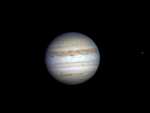
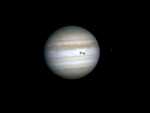
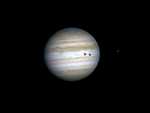
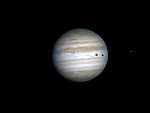
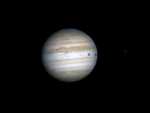
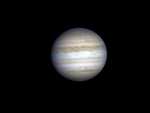
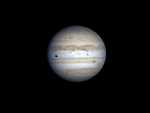
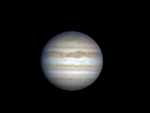
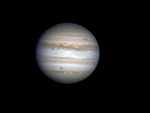
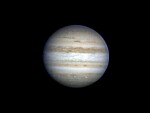
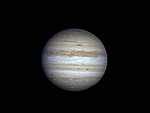
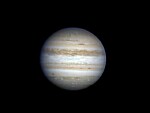
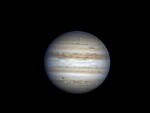
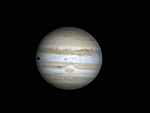
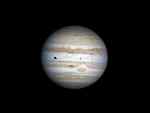
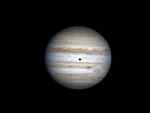
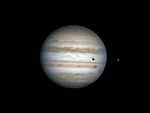
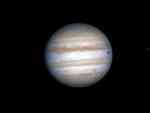
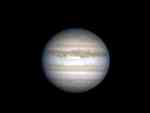
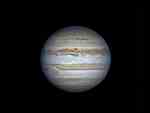
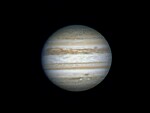
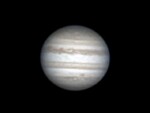
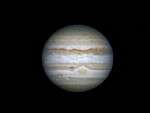
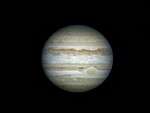
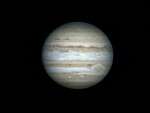
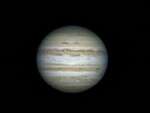
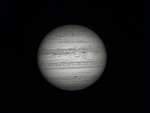
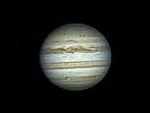
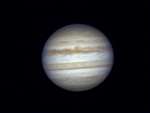
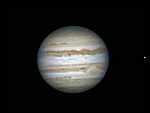
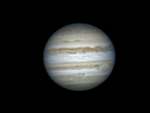
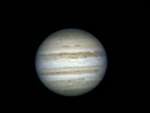
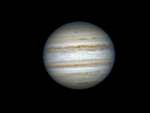
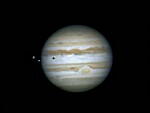
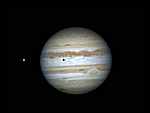
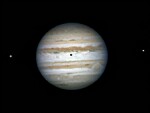
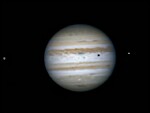
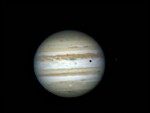
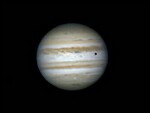
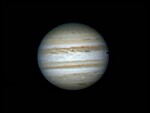
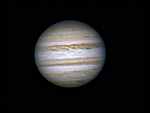
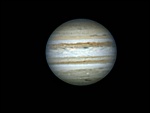
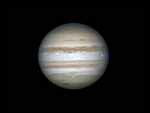
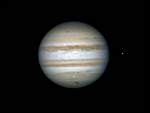
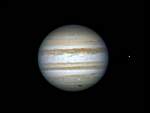
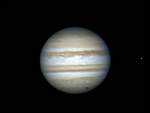
 Zip file with all 27 images from July 18th.
Zip file with all 27 images from July 18th.